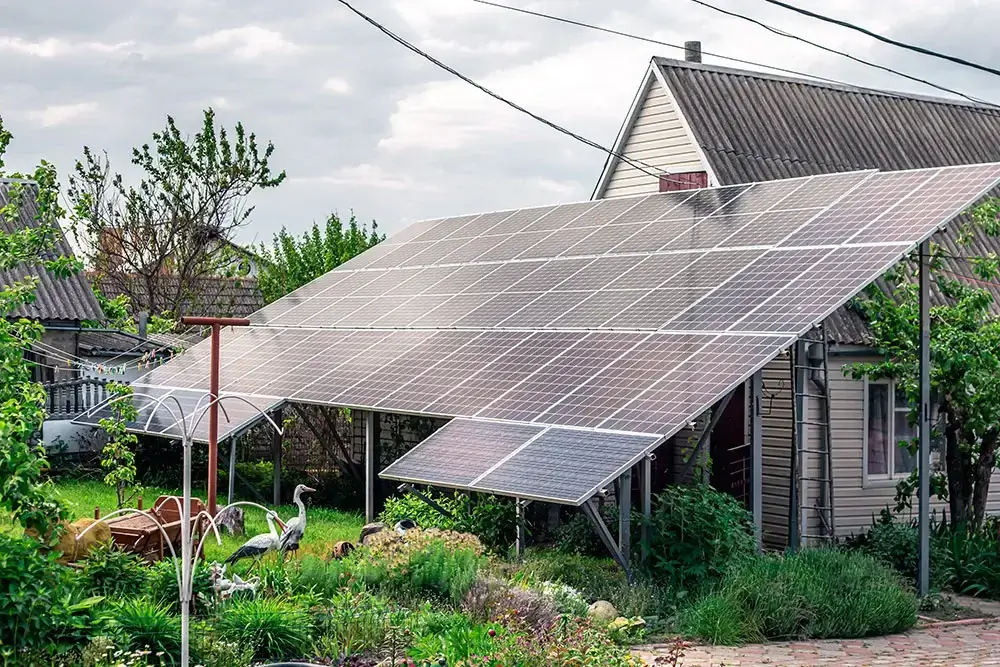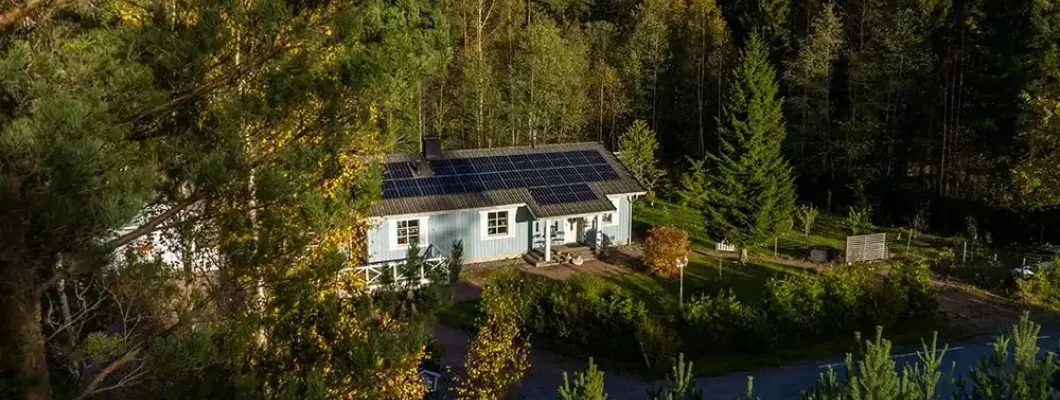Imagine ditching those sky-high utility bills, powering your home anywhere, and doing your part for the planet. That’s the promise of an off-grid solar system with batteries—a ticket to energy freedom. But before you dive in, there’s a lot to think about to make sure your investment pays off. So, what do you need to know before buying an off-grid home solar system? Is it even right for your home? Let’s break it down step by step with this ultimate checklist.
Understanding Off-Grid Solar Systems
What Is an Off-Grid Home Solar System?
An off-grid solar system is your personal power plant, completely independent of the utility grid. It’s like having your own mini utility company, generating and storing electricity to keep your home running 24/7. The main components include:
- Solar panels: Capture sunlight and convert it into electricity.
- Batteries: Store energy for use at night or during cloudy days.
- Inverter: Converts solar energy into usable AC power for your home.
- Charge controller: Protects batteries by managing energy flow.
Unlike grid-tied systems, which rely on the utility grid for backup, off-grid systems are self-sufficient. They’re perfect for remote areas where grid access is spotty or nonexistent, and they keep your lights on during blackouts.
Benefits of Going Off-Grid
Why go off-grid? Here’s what you gain:
- Energy independence: No more relying on utility companies or worrying about rate hikes.
- Zero utility bills: After the initial investment, your electricity is free.
- Eco-friendly living: Slash your carbon footprint with clean, renewable energy.
- Perfect for remote homes: Ideal for rural or off-the-beaten-path properties where grid connection is costly or unreliable.
If you’re dreaming of a self-sufficient lifestyle, off-grid solar is a game-changer, especially for folks in far-flung areas.

Key Factors to Consider
Ready to take the plunge? Here are the eight critical things to think about before buying an off-grid solar system.
1. Energy Needs Assessment
First things first: how much power does your home actually need? You can’t size your system without knowing your energy consumption. This starts with an energy audit, and here’s how to do it:
- List every appliance, light, and device in your home.
- Note their wattage (check labels or manuals) and daily usage (in hours).
- Multiply wattage by hours to get watt-hours (Wh) per device, then add them up for your daily total. Divide by 1,000 to convert to kilowatt-hours (kWh).
For example, a 100W TV used for 3 hours daily consumes 300 Wh (0.3 kWh). Tally everything to get your daily kWh.
Pay attention to base load (constant power needs, like a fridge) vs. peak load (high-power spikes, like an AC unit). This helps you size your system accurately. Pro tip: energy-efficient appliances can shrink your needs and save you money on the system. For a deeper dive into energy audits, check out the U.S. Department of Energy’s guide.
2. Battery Storage Capacity
Batteries are the heart of your off-grid system, storing energy for when the sun’s not shining. But picking the right battery and sizing it correctly is crucial. Here’s what to know:
- Autonomy days: This is how many days your batteries can power your home without sunlight (e.g., during cloudy weather). Most systems aim for 1-3 days.
- Battery types:
Battery Type Pros Cons Lithium-ion Long lifespan (10-15 years), lightweight, high efficiency Higher upfront cost Lead-acid Lower cost, widely available Shorter lifespan (5-7 years), heavier, requires maintenance Sodium-ion (emerging) Potentially cheaper, eco-friendly Limited commercial availability (as of 2025) - Sizing: Your battery capacity (measured in kWh) depends on your daily energy needs and autonomy days. For example, if you use 10 kWh daily and want 2 days of autonomy, you need at least 20 kWh of storage.
Lithium-ion batteries, particularly LiFePO4 (lithium iron phosphate) models, are the go-to for most off-grid setups due to their durability, safety, and efficiency. For more on why LiFePO4 is a top choice, check out this guide to LiFePO4 battery packs. Lead-acid batteries can work for budget-conscious buyers but require more upkeep. Always factor in battery replacement costs when budgeting.
3. Solar Panel Sizing and Placement
Your solar panels are the engine of your system, so you need the right number and optimal placement. Here’s how to get it right:
- Sizing: The number of panels depends on your energy needs and local solar insolation (how much sunlight your area gets). A 400W panel generates about 1.6-2 kWh daily in a sunny region. Divide your daily kWh needs by this to estimate panel count.
- Site assessment: Check for:
- Sun exposure: Aim for 6+ hours of direct sunlight daily.
- Shading: Trees, buildings, or hills can reduce output. Use a shading analysis tool to identify problem spots.
- Roof orientation: South-facing (in the Northern Hemisphere) is best, with a tilt matching your latitude.
- Seasonal angles: In high-latitude areas (e.g., northern U.S.), winter sun angles are lower, so adjust panel tilt or add more panels.
- Spacing: Ensure panels are spaced correctly to avoid shading each other. For more on optimal panel placement, see these installation tips.
A professional site assessment ensures you maximize energy production and avoid costly mistakes.
4. System Costs and Budget
Going off-grid isn’t cheap, but it’s a long-term investment. Here’s a cost breakdown:
- One-time costs:
- Solar panels: $0.50-$1 per watt (e.g., $5,000-$10,000 for a 10kW system).
- Batteries: $5,000-$15,000 for 10-20 kWh of lithium-ion storage.
- Inverter and charge controller: $1,000-$3,000.
- Installation: $5,000-$10,000, depending on complexity.
- Total: $15,000-$40,000 for a typical home system.
- Long-term costs:
- Battery replacement: Every 5-15 years, depending on type.
- Maintenance: Minimal but includes panel cleaning and system checks ($100-$500/year).
- Financing options:
- Loans: Solar-specific loans with low interest rates.
- Grants and incentives: In the U.S., the Investment Tax Credit (ITC) offers a 30% tax break (as of 2025). Check regional subsidies (e.g., Europe’s Feed-in Tariffs may apply indirectly).
- ROI: Expect to recoup through utility bill savings in 7-15 years, depending on your energy use and local electricity rates.
Crunch the numbers and explore incentives to make your system more affordable. For global insights on solar incentives, the International Renewable Energy Agency (IRENA) offers valuable resources.
5. Maintenance and Lifespan
Off-grid systems are low-maintenance but not maintenance-free. Here’s what to expect:
- Maintenance tasks:
- Clean panels every 3-6 months (more often in dusty or snowy areas) to maximize efficiency.
- Check wiring and connections annually for wear or corrosion.
- Monitor battery health: For lead-acid, balance charging and check fluid levels; for lithium-ion, ensure proper temperature control.
- Lifespan:
- Solar panels: 25-30 years (with minimal degradation).
- Batteries: 5-15 years (lead-acid shorter, lithium-ion longer).
- Inverters: 10-15 years.
- Extreme weather challenges:
- Snow: Clear panels promptly to maintain output.
- Dust: More frequent cleaning in arid regions.
- Heat: Ensure batteries are in a cool, ventilated space to extend lifespan.
A regular maintenance schedule keeps your system humming and avoids costly repairs.
6. Local Regulations and Permits
Before you install, check the rulebook. Regulations vary widely by country, state, or even county:
- Zoning laws: Some areas restrict solar panel placement (e.g., historic districts).
- Building codes: Ensure your system meets electrical and structural standards.
- Permits: Most regions require permits for off-grid systems, even in rural areas.
Contact your local government or a solar installer to confirm requirements. Skipping this step can lead to fines or forced system removal, so don’t cut corners.
7. Backup Power Options
Solar is reliable, but it’s not foolproof. Cloudy stretches or heavy energy use can strain your system, so consider backup options:
- Generators: Gas, diesel, or propane generators provide power during extended bad weather. They’re noisy and use fossil fuels, but they’re a solid safety net.
- Hybrid systems: Combine solar with wind, a small grid connection, or multiple energy sources for extra reliability.
- Regional needs: In hurricane-prone areas (e.g., Florida) or snowy regions (e.g., Vermont), backups are critical for uninterrupted power.
Factor backup costs and maintenance into your budget for peace of mind.
8. Choosing a Reputable Installer
A great system starts with a great installer. Here’s how to pick one:
- Look for certified professionals with off-grid experience (e.g., NABCEP certification in the U.S.).
- Ask key questions:
- How many off-grid systems have you installed?
- What warranties do you offer on equipment and labor?
- Do you know local climate conditions and regulations?
- Can you provide references or customer reviews?
- Do you offer 24/7 emergency support?
- Check online reviews and ask for past project examples.
A local installer familiar with your area’s weather and rules can make all the difference.
Avoid These Common Traps
Don’t let excitement lead to costly mistakes. Here are pitfalls to dodge:
- Undersizing your system: Skimping on panels or batteries leaves you short on power.
- Chasing cheap deals: Low-cost equipment often means low quality and early failures.
- Ignoring future needs: Plan for energy demand growth (e.g., new appliances or EVs).
- Skipping compatibility checks: Ensure panels, batteries, and inverters work seamlessly.
- Neglecting maintenance: Dirty panels or unmaintained batteries reduce efficiency.
- Overlooking regulations: Unpermitted systems can lead to legal headaches.
Take your time to plan thoroughly—it’s worth it.
Frequently Asked Questions
Can I power my entire home with an off-grid solar system?
Absolutely, but it depends on your energy needs and system size. A well-designed system can cover all your power demands, but high-energy homes (e.g., with AC or electric heating) require larger, pricier setups. Start with an energy audit to confirm feasibility.
How long can batteries last during cloudy days?
Your batteries’ runtime depends on their autonomy days—typically 1-3 days for most systems. For example, a 20 kWh battery can power a 10 kWh/day home for 2 days without sunlight. Size your battery bank based on your local weather patterns.
Are off-grid solar systems worth the investment?
They can be, both financially and beyond. You’ll save on utility bills long-term (often breaking even in 7-15 years), plus enjoy energy independence and a smaller carbon footprint. Weigh the upfront cost against your goals and local electricity rates.
Can I install an off-grid solar system myself?
Small, simple systems are DIY-friendly if you have electrical know-how, but large or complex setups are best left to pros. Mistakes can lead to safety hazards, inefficiencies, or voided warranties. If you go DIY, stick to pre-designed kits and follow local codes.
Conclusion
Going off-grid with a home solar system and batteries is an exciting step toward energy freedom, but it’s not a decision to rush. From sizing your system and batteries to navigating costs, maintenance, and regulations, careful planning is key. Start with a home energy audit, consult experienced installers, and use this checklist to avoid pitfalls. Your off-grid journey begins with smart choices—get started today and power your future sustainably!


Leave a Comment